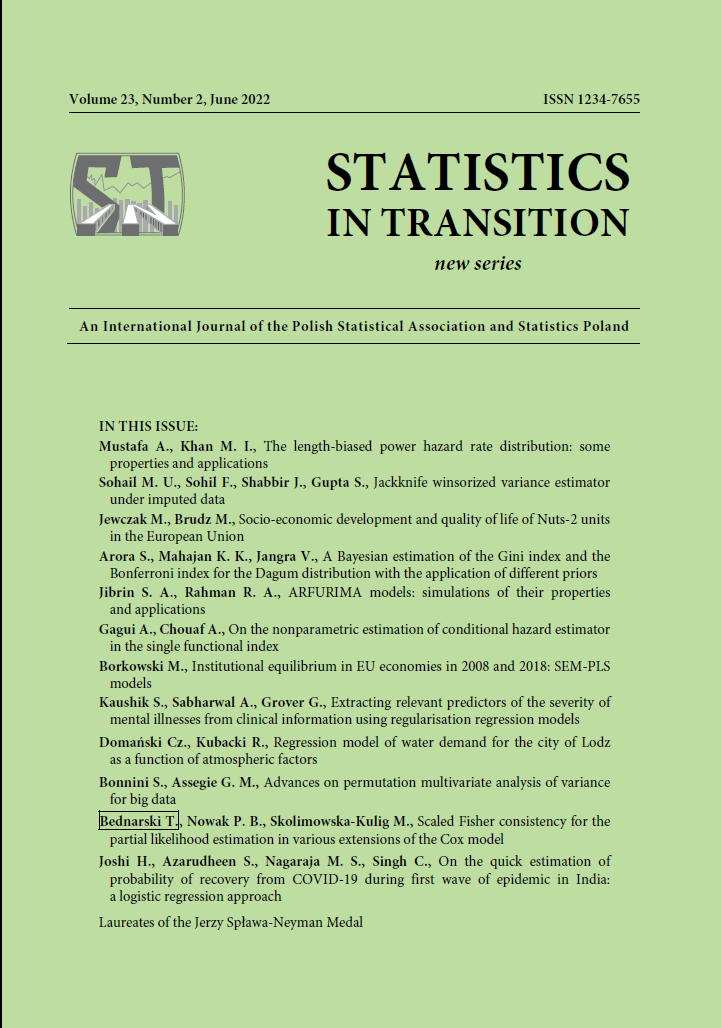© Fariha Sohil, Muhammad Umair Sohail, Javid Shabbir, Sat Gupta. Article available under the CC BY-SA 4.0
![]()
ARTICLE
ABSTRACT
In the present study, we consider the problem of missing and extreme values for the estimation of population variance. The presence of extreme values either in the study variable, or the auxiliary variable, or in both of them, can adversely affect the performance of the estimation procedure. We consider three different situations for the presence of extreme values and also consider jackknife variance estimators for the population variance by handling these extreme values under stratified random sampling. Bootstrap technique ABB is carried out to understand the relative relationship more precisely.
KEYWORDS
adjusted imputation, jackknife variance estimators, linearized jackknife, missing values, winsorized variance
REFERENCES
Chen, Q., Elliott, M. R., Haziza, D., Yang, Y., Ghosh, M., Little, R. J., and Thompson, M., (2017). Approaches to improving survey-weighted estimates. Statistical Science, 32(2), pp. 227–248.
Fay, R. E., (1993). Valid inferences from imputed survey data, "in proceedings of the survey research methods". Journal of the American Statistical Association, 1, pp. 227–232.
Korn, E. L., Graubard, B. I., (2011). Analysis of health surveys (Vol. 323), John Wiley & Sons.
Kovar, J. G., Chen, E. J., (1994). Jackknife variance estimation of imputed survey data. Survey Methodology, 20, pp. 45–52.
Little, R., Rubin, D. B., (1987). Statistical Analysis With Missing Data, New York: Wiley.
Mujtaba, A., Ali, M. and Kohli, K., (2014). Statistical optimization and characterization of pH-independent extended-release drug delivery of cefpodoxime proxetil using Box–Behnken design. Chemical Engineering Research and Design, 92(1), pp. 156–165.
Mohamed, C., Sedory, S. A. and Singh, S., (2016). Imputation using higher order moments of an auxiliary variable. Communications in Statistics-Simulation and Computation, 46(8), pp. 6588–6617.
Rao, J., (1996). On variance estimation with imputed survey data. Journal of the American Statistical Association, 91(434), pp. 499–506.
Rao, J., Sitter, R. R., (1992). Jackknife variance estimation under imputation for missing survey data. Technical Report 214 Carleton University, Laboratory for Research in Statistics and Probability.
Rao, J. N. and Shao, J., (1992). Jackknife variance estimation with survey data under hot deck imputation. Biometrika, 79(4), pp. 811–822.
Rao, J. N., Sitter, R., (1995). Variance estimation under two-phase sampling with application to imputation for missing data. Biometrika, 82(2), pp. 453–460.
Rao, J. N. K., (1996). On variance estimation with imputed survey data. Journal of the American Statistical Association, 91(434), pp. 499–506.
Little, R. J., Rubin, D. B., (2019). Statistical analysis with missing data, Vol. 793, John Wiley & Sons.
Rudolf, F. J., William, W. J. and Ping, S., (2006). Regression analysis: statistical modeling of a response variable. Elsevier.
Rubin, D. B., (1976). Inference and Missing Data. Biometrika, 63(3), pp. 581–592.
Rubin, D. B., (1978). Multiple imputations in sample surveys-a phenomenological Bayesian approach to nonresponse. Journal of the American Statistical Association, 1, pp. 20–34.
Rubin, D. B., Schenker, N., (1986). Multiple imputation for interval estimation from simple random samples with ignorable nonresponse. Journal of the American Statistical Association, 81(394), pp. 366–374.
Sarndal, C.-E., (1992). Methods for estimating the precision of survey estimates when imputation has been used. Survey Methodology, 18(2), pp. 241–252.
Sitter, R., (1997). Variance estimation for the regression estimator in two-phase sampling. Journal of the American Statistical Association, 92(438), pp. 780–787.
Whitridge, P., Kovar, J., (1990). Use of mass imputation to estimate for subsample variables, 1, pp. 132–137.
Wolter, K., (1985). Introduction to Variance Estimation, New York: Springer-Verlag.
